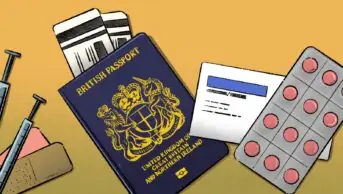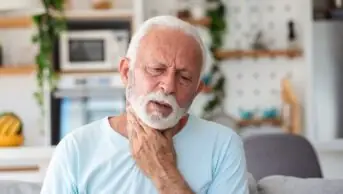
B. BOISSONNET/BSIP/SCIENCE PHOTO LIBRARY
After reading this article, you should be able to:
- Explain the importance of safety-netting and when it is appropriate;
- Describe the elements to include when safety-netting;
- Deliver safety-netting advice to patients and adequately document it.
What is safety-netting advice?
Safety-netting advice is information shared with a patient (or carer) to help them identify the need to seek further help if their condition fails to improve or changes[1]. Safety-netting is currently recommended as a strategy for managing patient risk in clinical guidelines and patient group directions (PGDs). PGDs allow registered healthcare professionals, including some pharmacists, to supply and/or administer specified medicines to a pre-defined group of patients, without them having to see a prescriber. Safety-netting advice differs to other advice provided by clinicians to patients because it is contingent on a future state of affairs (e.g. if symptoms worsen rapidly or significantly). It can also be used, if documented, to defend against an allegation of negligence. Safety-netting advice is usually associated with the management of diagnostic uncertainty; however, it can also be employed to manage treatment uncertainty or medicines-related problems[1].
Why is safety-netting important?
Robust safety-netting can help patients and carers play a greater role in self-management, reduce the potential for harm, and improve the patient’s diagnostic journey by avoiding unnecessary referrals or contact for relatively well patients[2–4]. By contrast, inadequate safety-netting can contribute to delayed diagnoses, delayed referrals or failure to refer, resulting in safety incidents and avoidable emergency situations[5,6]. As well as causing patients and families harm, anxiety and distress, such incidents also carry the potential for harm, anxiety and distress for staff, reputational damage to organisations, and high NHS medico-legal costs[7]. Despite this, safety-netting is often absent or under-emphasised in clinical communication skills teaching[8]. Research has shown that safety-netting advice is not always given and, when it is provided, it is not always done optimally[9]. Patients and carers have reported not being able to remember safety-netting advice given by clinicians, and that it was unhelpful or not specific enough to the patient/situation[4,10].
Safety-netting is particularly important for healthcare professionals working outside of GP settings, such as community pharmacy or urgent care. Patients often present early on in their illness, with symptoms that are non-specific and common to both serious and minor illnesses[8]. The strategies available in GP settings to manage diagnostic uncertainty, such as test of time, therapeutic trials or further investigations, are usually impractical for settings where care is unscheduled[2]. Patients will often be ‘new’ to the healthcare professional and access to their GP records may be restricted. There is also often no continuity of care in terms of follow-up and feedback on what happened next (outside of the GP setting).
When to ‘safety-net’ a patient
Safety-netting is appropriate for all treatment outcomes. However, experts have agreed that it should be mandatory in the following circumstances:
- When the diagnosis is uncertain, and the differential diagnosis includes serious illness, particularly illness that can progress rapidly;
- When the diagnosis is certain but carries a known risk of developing serious complications;
- When the patient has an increased risk of serious illness or complications[2].
However, it is also important to consider the patient — specifically their capability and legal competence to assess the state of their own health, and their ability to practically follow the advice given[8]. This will determine with whom, and the extent to which, you feel the responsibility for future action may be shared.
People are used to visiting their community pharmacies for advice on medicines and symptomatic treatment of minor illnesses. Since the launch of the NHS Pharmacy First service across England, participating pharmacies are able to undertake clinical assessment of patients[11]. Specifically, they can consult, advise and provide treatment, including prescription-only medicines or a GP referral, for several common conditions. These include acute otitis media in children and young people, suspected lower urinary tract infections (UTIs) in women aged under 65 years, sore throat in patients aged over 5 years old, acute sinusitis in patients aged 12 years or older, shingles in adults, impetigo, and infected insect bites and stings in patients aged over 1 year. Although many of these conditions are self-limiting (i.e. resolving without the need for treatment), some clinical features are shared with more serious illnesses. At the point of contact, it may be difficult to differentiate minor illness from something more serious[12].
To mitigate risk, clinical pathways for each condition have been developed by professional experts and approved by NHS England and the Chief Medical Officer. Pharmacists and pharmacy staff using these pathways should follow specific PGDs and use Public Health England’s diagnostic tools for primary care or NICE clinical knowledge summaries when checking criteria for inclusion[13]. The PGDs recommend safety-netting patients when treatment with a prescription-only medicine is not indicated, or where patients decline treatment. However, safety-netting is appropriate even when treatment is prescribed, so that patients and carers know to seek medical advice if adverse reactions occur or treatment fails, as an alternative diagnosis may be indicated.
Certain patients, owing to age, comorbidity or being immunosuppressed, carry the risk of their condition worsening rapidly/significantly or developing more serious complications[2]. Symptoms can also worsen as a result of treatment failure. With bacterial infections, treatment failure may be owing to previous antibiotic use, leading to resistant organisms. Lower urinary tract infections (UTIs) may develop into an upper UTI, pyelonephritis or even sepsis.
Safety-netting may also be appropriate when discussing a patient’s treatment or management plan. Examples include:
- Advising a patient who is starting a new long-term medicine about possible side effects;
- During a reactive structured medication review, following requests from other healthcare or social care professionals, patients or family members, because of a concern about medication;
- Conducting a scheduled proactive structured medication review for a patient with complex polypharmacy and trialling stopping a long-term medicine.
Box: Example — safety-netting for side effects
A pharmacist asks Katie, aged 68 years, if she has experienced any side effects from one of her regular medicines (ramipril). Katie says that her husband has noticed that she has been coughing in the mornings.
Pharmacist: If you think that the cough is getting worse, you come and you let me know.
Katie: Right.
Pharmacist: And we’ll try the alternative.
Katie: OK, thanks.
The safety-net here concerns the management of a known side effect of ramipril — dry cough. The pharmacist advises Katie that if the cough gets worse, she can let them know and an alternative medicine can be provided. This could prevent an unnecessary GP appointment, improve the patient’s quality of life or prevent future harm if the patient decided to stop taking the medicine.
Tips for best practice
The advice in this section is informed by a clinical consensus study and systematic observations from recordings of how safety-netting advice is delivered and documented by real clinicians in primary care settings[2,9,14]. It assumes that the person giving the advice is satisfied that the recipient is someone with whom responsibility for future action may be shared.
1. Inform patients about the time course of symptom resolution
All clinical guidance for common conditions recommends that you inform patients, or their caregivers, about the expected time course for recovery (e.g. explaining that sore throat can last for around one week). Although giving information about the usual time course is not always observed during safety-netting, it can allow for managing expectations for symptom resolution and help give context for an informed decision about whether to seek reassessment[9].
2. Recommend a treatment plan, including any self-care advice
Although treatment with a prescription-only medicine may sometimes be indicated, many common illnesses or conditions are self-limiting. Advice on supportive management (e.g. interventions to manage symptoms, such as pain or fever, at home) is often relevant, either as the main treatment plan or alongside treatment with prescription medicine.
3. Share any diagnostic uncertainty or possible complications
Sharing any uncertainty, such as the possibility of an alternative diagnosis or complications, means the patient or caregiver will be alert for signs of potential trouble. It can also act as a clear rationale for further safety-netting. For example: “Although you’re otherwise young, fit and healthy, tonsillitis can occasionally require treatment in hospital.”
4. Inform patients about what exactly to look out for
Safety-netting advice is usually delivered as a contingent recommendation for a next action step, i.e. ‘If X happens, then do Y’[1]. The ‘If X happens’ part conveys what the patient or caregiver should be looking out for and a time frame for reassessment specific to the condition[15]. Being specific and tailoring advice to the patient’s circumstances is important. For example: “If within the next few days she has a fever that’s not going away, if there’s any discharge…” is detailed enough to be useful. If the advice is not specific — for example “If there are any problems” — it could hamper the patient’s or caregiver’s ability to responsibly monitor the situation[2].
5. Recommend how and where to seek further help
Following on from the above step, ‘Then do Y’ provides a clear directive about the next action, including who is the responsible agent. It should be specific about how and where to seek further help, and tailored to the level of clinical risk. There is always a chance that the patient may not return, especially if the responsibility is placed solely on them[15]. Therefore, the pharmacist must convey an appropriate sense of urgency for the situation; for example: “You can return to the community pharmacy for reassessment” versus “You must seek immediate medical attention by calling 999 or going to A&E”.
6. Seek acceptance and confirmation of understanding/commitment
The only way to assess your patient’s understanding of and commitment to following the advice is to observe their response to it at the time. It is important, therefore, to allow the patient, or their caregiver, an opportunity to respond, and to subsequently seek confirmation that they have understood the advice. At the least, the recipient’s initial response should be followed up by asking if they are happy with the advice or if they have any questions concerning it. Any issues can then be addressed.
Pharmacist: OK?
Patient: Yeah.
Pharmacist: Any questions about any of that?
Patient: There’s nothing dangerous about this?
7. Summarise the advice
Accurate recall of safety-netting advice by adult patients following face-to-face GP consultations has been found to be suboptimal, at 68%[16]. To aid recall, it is generally best to give safety-netting advice once during treatment planning and then summarise it at the end of the consultation.
This provides another opportunity to confirm that the patient understands and is committed to following the advice[17]. Where possible, reinforce verbal advice with further written information and support that includes safety-netting advice (e.g. TARGET leaflets, British Association of Dermatologists patient information leaflets, or via text message)[18,19].
8. Document the advice given
Document the safety-netting advice given in the appropriate clinical record. A study of routine primary-care consultations found that when safety-netting advice had been given to a patient, the advice was documented in their electronic health record in only 47% of cases[14]. Avoid using a generic template or simply entering a generic note (e.g. “worsening advice given”). The Royal College of General Practitioners’ Urgent and Emergency Care Clinical Audit Toolkit recommends recording your advice fully (e.g. “Explained to patient and wife if worsening then see own GP within 24 hours. Happy with outcome”)[20]. Any signposting to further information and support can be documented here too.
Conclusion
Safety-netting is essential for managing diagnostic and treatment uncertainties during the consultation. The main elements to remember when giving safety-netting advice are to consider the recipient; set the context to help the patient make an informed decision about reassessment; optimise the delivery of the advice; ensure the advice has been heard and understood; and document the advice fully. Robust safety-netting can help keep patients safe and reduce unnecessary prescribing or onward referral. If advice is recorded fully, it can also afford some legal protection.
Disclosures
Rebecca Barnes’ research addresses professional/practical problems in the communication of patient risk, which she approaches as a conversation analyst. She co-developed the Safety-Netting Coding Tool (SaNCoT), which was based on her original observations of safety-netting practices in the UnPAC study. She has also developed a module, ‘Safety netting for common infections in out-of-hours primary care,’ for NHS England’s e-learning for healthcare programme ‘Antimicrobial Stewardship (AMS) Out of Hours’.
- 1Edwards PJ, Ridd MJ, Sanderson E, et al. Development of a tool for coding safety-netting behaviours in primary care: a mixed-methods study using existing UK consultation recordings. Br J Gen Pract. 2019;69:e869–77. https://doi.org/10.3399/bjgp19x706589
- 2Almond S, Mant D, Thompson M. Diagnostic safety-netting. Br J Gen Pract. 2009;59:872–4. https://doi.org/10.3399/bjgp09x472971
- 3Jones D, Dunn L, Watt I, et al. Safety netting for primary care: evidence from a literature review. Br J Gen Pract. 2018;69:e70–9. https://doi.org/10.3399/bjgp18x700193
- 4Maguire S, Ranmal R, Komulainen S, et al. Which urgent care services do febrile children use and why? Archives of Disease in Childhood. 2011;96:810–6. https://doi.org/10.1136/adc.2010.210096
- 5Payne R, Clarke A, Swann N, et al. Patient safety in remote primary care encounters: multimethod qualitative study combining Safety I and Safety II analysis. BMJ Qual Saf. 2023;bmjqs-2023-016674. https://doi.org/10.1136/bmjqs-2023-016674
- 6Rees P, Edwards A, Powell C, et al. Patient Safety Incidents Involving Sick Children in Primary Care in England and Wales: A Mixed Methods Analysis. PLoS Med. 2017;14:e1002217. https://doi.org/10.1371/journal.pmed.1002217
- 7Roland D, Jones C, Neill S, et al. Safety netting in healthcare settings: what it means, and for whom? Arch Dis Child Educ Pract Ed. 2013;99:48–53. https://doi.org/10.1136/archdischild-2012-303056
- 8Silverston P. The Importance of Teaching Risk Assessment and Safety-Netting Skills in Primary Care. Primary Health Care. 2014;04. https://doi.org/10.4172/2167-1079.1000146
- 9Edwards PJ, Ridd MJ, Sanderson E, et al. Safety netting in routine primary care consultations: an observational study using video-recorded UK consultations. Br J Gen Pract. 2019;69:e878–86. https://doi.org/10.3399/bjgp19x706601
- 10Cabral C, Ingram J, Hay AD, et al. “They just say everything’s a virus”—Parent’s judgment of the credibility of clinician communication in primary care consultations for respiratory tract infections in children: A qualitative study. Patient Education and Counseling. 2014;95:248–53. https://doi.org/10.1016/j.pec.2014.01.010
- 11Pharmacy First. NHS England. 2024. https://www.england.nhs.uk/primary-care/pharmacy/pharmacy-services/pharmacy-first/ (accessed May 2024)
- 12Silverston P. Using a model of illness to aid symptom-based learning in primary care. Research Gate. 2012. https://www.researchgate.net/publication/233900652_Using_a_model_of_illness_to_aid_symptom-based_learning_in_primary_care (accessed May 2024)
- 13Community Pharmacy advanced service specification: NHS Pharmacy First Service. NHS England. 2024. https://www.england.nhs.uk/publication/community-pharmacy-advanced-service-specification-nhs-pharmacy-first-service/ (accessed May 2024)
- 14Edwards PJ, Bennett-Britton I, Ridd MJ, et al. Factors affecting the documentation of spoken safety-netting advice in routine GP consultations: a cross-sectional study. Br J Gen Pract. 2021;71:e869–76. https://doi.org/10.3399/bjgp.2021.0195
- 15Almond SC, Summerton N. Test of time. BMJ. 2009;338:b1878–b1878. https://doi.org/10.1136/bmj.b1878
- 16McKinstry B, Watson P, Elton RA, et al. Comparison of the accuracy of patients’ recall of the content of telephone and face-to-face consultations: an exploratory study. Postgraduate Medical Journal. 2011;87:394–9. https://doi.org/10.1136/pgmj.2010.101287
- 17GAFARANGA J, BRITTEN N. Formulation in general practice consultations. Text – Interdisciplinary Journal for the Study of Discourse. 2004;24. https://doi.org/10.1515/text.2004.006
- 18Leaflets to discuss with patients. RCGP Learning. 2021. https://elearning.rcgp.org.uk/mod/book/view.php?id=12647&chapterid=440 (accessed May 2024)
- 19Shingles (Herpes zoster infection) . British Association of Dermatologists. 2020. https://cdn.bad.org.uk/uploads/2021/12/19174036/Shingles-PIL-May-2020.pdf (accessed May 2024)
- 20Urgent and Emergency Care Clinical Audit Toolkit. Royal College of General Practitioners and The College of Emergency Medicine. 2010. https://rcem.ac.uk/wp-content/uploads/2021/11/Urgent_and_Emergency_Care_Clinical_Audit_Toolkit.pdf (accessed May 2024)


